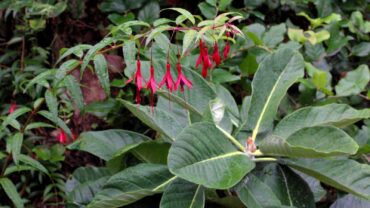
The new year is an exciting time for Northwest rhododendron fans — it marks the beginning of the flowering season for these popular, well-loved shrubs. Even non-gardeners can recognize rhododendrons.
What comes to mind when thinking about a rhododendron? For many people, it’s a large truss comprised of many blossoms. The evergreen leaves will be seen for the next 50 to 51 weeks until the next floral show — and what a show it is! Considering the shrubs only flower for a couple of weeks in the year, selecting foliage is also essential.
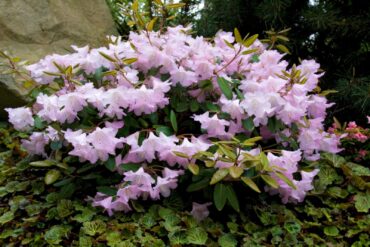
We think about rhododendrons as medium-size, mounding shrubs. Yet they come in differing heights and leaf sizes. Some, such as Rhododendron calostrotum subsp. Keleticum, grow only a few inches high. On the opposite scale, Rhododendron arboretum will grow 80 feet tall in the wild.
Rhododendrons and azaleas are all classified as rhododendrons in the Ericaceae family. There are thousands of species, and from them come many hybrids and select forms. When they’re flowering, it’s easy to identify an azalea versus a rhododendron. Azaleas have five stamens while rhododendrons have 10 or more.
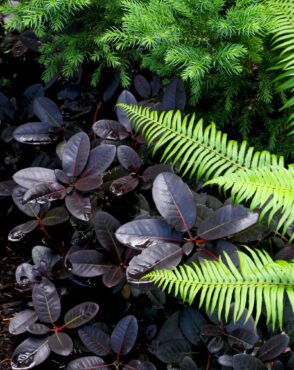
Let’s talk about the foliage since this is what will be prominent most of the year. Azalea leaves are either evergreen or deciduous. The deciduous leaves of some varieties show off their true colors in a significant fall display or have brightly hued, new foliage in the spring.
In the rhododendron group, all but a few species are evergreen. The evergreen rhododendrons come in a variety of shapes and sizes. A few of them have variegated leaves. Others have pet-able, felt-like hair underneath the leaves (indumentum) or on the top side of the leaves (tomentum). Those rhodos are much sought after by collectors and enthusiasts. Some of the giant leaves are seen on R. macabeanum and R. sinogrande.
Many rhododendron species and varieties grow naturally as trees, yet are mistakenly planted to be bushy plants in the landscape. The trees end up turning into gangly rhododendrons, with homeowners wondering how to prune them back to be blousy shrubs. To revive it into a shrub, eventually you need to chop it back to nothing. It only grows to its tall proportions again or dies — or you may simply give up and yank it out.
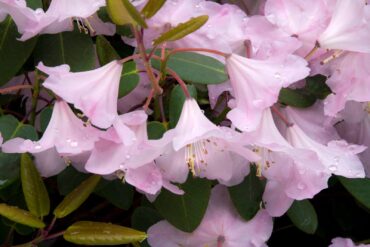
The poor tree never had a chance to grow into and show off its tree-ness. If appropriately developed to achieve their lofty goal, these trees would show off their beautiful trunks, some with exfoliating bark and an overhead roof of foliage that would look right at home in a tropical garden. Underneath the canopy, shade-loving ferns and small shrubs such as sarcococca, perennials and bulbs will grow.
Can you imagine strolling under the large leaves of a rhododendron tree with huge trusses overflowing with flowers? As much as we love them, we should take advantage of them as trees in the landscape. After all, the name rhododendron comes from the Greek words rhodo meaning rose and dendron meaning tree.
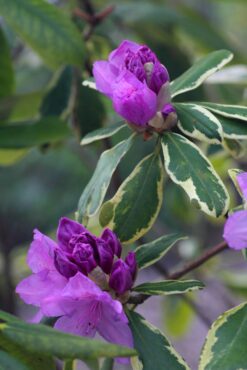
Rhododendrons of Note
Rhododendron ‘851c’
More popularly known as the Everred rhododendron, it has deep, reddish-purple leaves that are sought after as the shrub’s best feature. It flowers sparsely with dark red-purple blossoms, but that is no matter; the plant is grown for its stunning foliage. Put this one to bed with the native sword ferns (Polystichum munitum) for a unique texture and color contrast.
- Height and width: 2 feet by 3 feet
- Light: dappled shade or morning sun with afternoon shade
Rhododendron ‘Kimberly’
In April, the evergreen leaves cover the shrub in an abundance of slightly fragrant, pastel pink flowers. Purple bud scales add interest in winter.
- Height and width: 3 feet
- Light: partial sun to partial shade
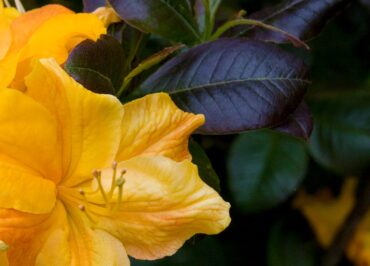
Rhododendron macabeanum
This tree species is also grown for its outstanding, 12- to 18-inch-long foliage that illustrates both indumentum and tomentum. Although it may never reach its full height potential of 50 feet in the wild, it will stand out at 12 to 15 feet in the garden.
It takes about 10 years before it will show its deep-yellow-to-cream flowers in early spring. But you will grow it for its leaves.
Another impressively large leaf species to consider is R. sinogrande. A mature specimen can have leaves that are 3 feet long by 1 foot wide.
- Height and width: 5 feet (10 years)
- Light: partial sun to partial shade
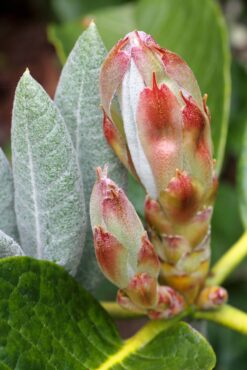
Rhododendron ponticum ‘Variegatum’
This shrub is sometimes referred to as Rhododendron ‘Cheiranthifolium’ or R. ponticum var. cheiranthifolium. The variegated, evergreen leaves of green with creamy-white margins make this rhododendron a good specimen all year; the trusses of purple flowers open from deep purple buds in May. The creamy edges will scorch if not protected from the afternoon sun.
- Height and width: 6-8 feet
- Light: partial shade
Rhododendron ‘Arneson Gem’
The flower’s red buds are streaked with yellow and open their blossoms with yellow throats and reddish-orange shading at the margins. The lightly scented flowers debut around mid-May. In autumn, the leaves turn a rich, purple-red before the shrub sheds its leaves.
- Height and width: 3 feet by 4 feet
- Light: dappled shade
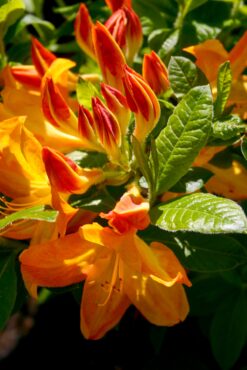
Rhododendron ‘Klondyke’
The mildew-resistant R. ‘Klondyke’ is considered a superior choice. Bronzy new foliage holds its own during bloom time and slowly turns green. In the fall, the deciduous leaves give a last hurrah, turning copper-red before they fall. In spring, the red flower buds open to a golden yellow.
It’s no wonder this hybrid is an award-winning rhododendron. The mounding shrub received an Award of Garden Merit from the Royal Horticultural Society. The American Rhododendron Society gave it the Rhododendron of the year award 2010 for the mid-Atlantic region and 2012 in the Great Lakes region.
- Height and width: 6-8 feet by 4-6 feet
- Light: full sun to partial sun
Rhododendron ‘Point Defiance’
This one became known as the largest flower from seedlings from the ‘Walloper’ group bred in Seattle by the late Halfdan Lem. The truss can measure as tall as 18 inches, with leaves 24 inches long. Is bigger better? You decide, but in the meantime, enjoy the flowers opening from deep pink buds. The center of the flower is white with deep pink edges. ‘Point Defiance’ wants to be a tree and is unsuitable for the popular “in front of the window” position.
- Height and width: 15 feet by 20 feet
- Light: full sun to partial sun
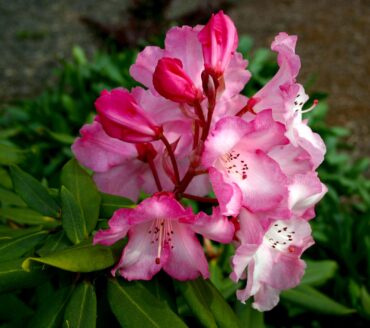
Culture Tips
Rhododendrons, with few exceptions, are best grown in acidic soil. Take heart, as most areas west of the Cascades have low pH levels suitable for them. It’s not necessary to change the pH in most cases. Where rhodos fail to thrive next to foundations, sidewalks or regularly limed lawns, it’s because cement leaches into the surrounding soil and causes the pH levels to rise.
Before adjusting the pH, test your soil using an inexpensive and easy-to-use testing kit. You can purchase one at your local garden center or hardware store. The optimum pH will be 4.5 to 6.0. If the level is higher, rhododendrons can suffer from chlorosis. One of the symptoms is yellowing leaves with dark green veining.
It’s crucial to select the correct-size plant to fit the space and grow naturally to its full potential. A common mistake is to plant one in front of a window. In a few years, the view becomes entirely obliterated by a rhododendron too large for the space.
Plant your rhododendrons at the same level as the pot. Because they’re shallow-rooted, mulching is essential for most of them. Take care not to pile the material up against the trunk. Leaf mold, wood chips, shredded bark mulch (3 inches), conifer needles (4 inches) and coffee grounds (half inch) are some of the suggested materials to use.
Fertilizing isn’t necessary when the shrubs grow in fertile soil. If the ground is not fertile, use a fertilizer formulated for rhododendrons. It’s essential not to exceed recommended application rates, as too much fertilizer can harm the plant by damaging the roots and leaves. There are even a few rhododendrons that will die from fertilizers.
Rhododendrons need consistently moist soil. During the annual summer-to-early-autumn drought, it’s vital to attend to their watering needs. However, older, established shrubs can survive a long drought with less frequent watering.






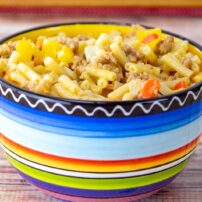























Comments